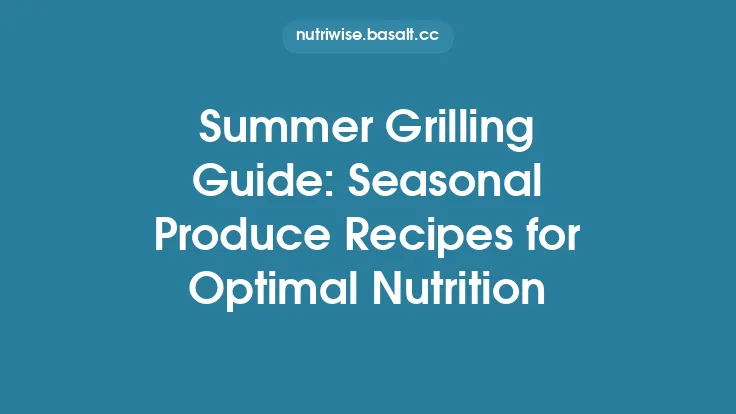Summer heat brings a unique set of challenges for the body. As temperatures rise, sweat loss accelerates, and with it, the depletion of water and essential minerals—sodium, potassium, magnesium, calcium, and chloride—known collectively as electrolytes. While the instinctive response is to reach for a cold beverage, the quality of that fluid matters just as much as the quantity. Proper hydration is not merely about quenching thirst; it is about maintaining the delicate balance of electrolytes that support nerve transmission, muscle contraction, fluid distribution, and overall cellular function. In the summer months, the abundance of fresh, water‑rich produce offers a natural, nutrient‑dense avenue to replenish both water and electrolytes simultaneously. By integrating these seasonal foods into daily meals and snacks, you can create a holistic hydration strategy that goes beyond sugary sports drinks and plain water, supporting performance, recovery, and long‑term health.
Why Hydration Matters in Summer
- Thermoregulation: Sweat is the body’s primary cooling mechanism. Each gram of sweat contains roughly 0.9 g of sodium and varying amounts of potassium, magnesium, and calcium. Losing too much fluid or electrolytes impairs the ability to dissipate heat, leading to elevated core temperature and heat‑related illnesses.
- Cardiovascular Load: Dehydration reduces plasma volume, forcing the heart to work harder to maintain blood pressure and deliver oxygen. Even a 2 % loss in body water can increase heart rate by 10–20 beats per minute during moderate activity.
- Neuromuscular Function: Electrolytes are essential for generating action potentials. Low sodium or potassium can cause muscle cramps, weakness, and, in severe cases, arrhythmias.
- Cognitive Performance: Mild dehydration (as little as 1 % body weight loss) has been linked to reduced attention, slower reaction time, and impaired short‑term memory—critical factors for driving, operating machinery, or even enjoying outdoor recreation safely.
Electrolytes: Functions and Sources
| Electrolyte | Primary Physiological Role | Typical Dietary Sources | Approx. Content per Serving |
|---|---|---|---|
| Sodium (Na⁺) | Maintains extracellular fluid volume, nerve impulse transmission | Table salt, seaweed, olives, pickles, canned soups | 1 g Na ≈ 2.5 g salt |
| Potassium (K⁺) | Intracellular fluid balance, muscle contraction, insulin secretion | Bananas, avocados, watermelon, tomatoes, leafy greens | 1 medium banana ≈ 422 mg |
| Magnesium (Mg²⁺) | Cofactor for >300 enzymatic reactions, muscle relaxation, DNA synthesis | Nuts, seeds, leafy greens, beans, whole grains | 1 oz almonds ≈ 80 mg |
| Calcium (Ca²⁺) | Bone health, blood clotting, muscle contraction | Dairy, fortified plant milks, kale, broccoli | 1 cup fortified soy milk ≈ 300 mg |
| Chloride (Cl⁻) | Works with sodium to maintain osmotic pressure, stomach acid production | Table salt, tomatoes, lettuce, olives | 1 tsp salt ≈ 2.3 g Cl⁻ |
While the body can store some electrolytes, the turnover is rapid during hot weather. Therefore, regular intake through both fluids and food is essential.
Seasonal Summer Produce Rich in Electrolytes
Summer’s bounty is not only colorful and flavorful; many of its staples are naturally high in water and electrolytes.
- Watermelon: Over 90 % water, it supplies 170 mg of potassium per 100 g and modest amounts of magnesium and calcium. Its natural sugars also aid rapid fluid absorption.
- Cucumber: Crisp and hydrating, cucumbers provide 147 mg of potassium per 100 g and a small amount of sodium, making them ideal for light salads.
- Tomatoes: Fresh tomatoes deliver 237 mg of potassium per 100 g and 19 mg of magnesium, plus lycopene, an antioxidant that supports skin health under sun exposure.
- Bell Peppers: Red and yellow varieties contain 211 mg of potassium per 100 g and are a good source of vitamin C, which can help mitigate oxidative stress from UV radiation.
- Zucchini: Offers 261 mg of potassium per 100 g and a modest calcium contribution, while being low in calories.
- Leafy Greens (e.g., spinach, arugula): Spinach provides 558 mg of potassium and 79 mg of magnesium per 100 g, making it a powerhouse for electrolyte replenishment.
- Coconut Water: Naturally occurring electrolyte drink, containing ~600 mg potassium, 250 mg sodium, and 60 mg magnesium per cup.
- Berries (e.g., strawberries, blueberries): While not as high in electrolytes, they add flavor and antioxidants without adding excessive sugar.
Creating Balanced Hydration Strategies
- Baseline Fluid Intake: Aim for 30–35 ml of water per kilogram of body weight daily, adjusting upward based on activity level and ambient temperature. For a 70 kg adult, this translates to roughly 2.1–2.5 L of fluid per day.
- Pre‑Exercise Electrolyte Loading: Consume a snack containing 200–300 mg of potassium and 100–150 mg of sodium 60–90 minutes before prolonged outdoor activity. A banana with a small handful of salted nuts works well.
- During Exercise: For activities lasting less than 60 minutes, water is sufficient. For longer sessions, incorporate a beverage or food source providing 300–500 mg of sodium and 200–300 mg of potassium per hour. Homemade electrolyte drink (see recipes below) can be tailored to personal taste.
- Post‑Exercise Replenishment: Within 30 minutes of finishing, aim for a 3:1 ratio of water to electrolytes (e.g., 500 ml water + 150 mg sodium + 300 mg potassium). Pair with a protein‑rich snack to aid muscle recovery.
- Everyday Meals: Structure meals to include at least one electrolyte‑rich fruit or vegetable per sitting. For example, a summer salad with mixed greens, cucumber, tomato, and a sprinkle of feta cheese provides a balanced electrolyte profile.
Practical Recipes and Meal Ideas
1. Electrolyte‑Boosted Watermelon‑Cucumber Cooler
*Ingredients:*
- 2 cups cubed watermelon
- 1 cup diced cucumber
- ½ cup coconut water
- Juice of ½ lime
- Pinch of sea salt (≈ 150 mg sodium)
- Fresh mint leaves (optional)
*Method:* Blend all ingredients until smooth, strain if desired, and serve over ice. This drink delivers ~400 mg potassium, 150 mg sodium, and 150 ml of water per serving.
2. Summer Electrolyte Salad
*Base:* Mixed spinach and arugula (2 cups)
*Additions:* ½ cup sliced strawberries, ¼ cup sliced almonds (salted), ½ avocado, ½ cup cherry tomatoes, ¼ cup crumbled feta.
*Dressing:* 2 tbsp olive oil, 1 tbsp apple cider vinegar, ¼ tsp sea salt, ¼ tsp black pepper.
*Nutrition Snapshot:* Approx. 600 mg potassium, 200 mg sodium, 80 mg magnesium, 150 mg calcium.
3. Savory Quinoa‑Veggie Bowl
*Ingredients:*
- 1 cup cooked quinoa (cooled)
- ½ cup roasted zucchini and bell pepper cubes (lightly salted)
- ¼ cup black beans (rinsed)
- 2 tbsp pumpkin seeds (unsalted)
- 2 tbsp tahini‑lemon dressing (tahini, lemon juice, water, pinch of salt)
*Electrolyte Content:* ~350 mg potassium, 250 mg sodium, 70 mg magnesium, 40 mg calcium.
4. Homemade Electrolyte Drink (for athletes)
*Ingredients per liter:*
- 1 L filtered water
- ½ tsp sea salt (≈ 1,150 mg sodium)
- ¼ tsp potassium chloride (optional, “No‑Salt” substitute)
- 2 tbsp honey or maple syrup (for rapid carbohydrate absorption)
- Juice of 1 orange (≈ 250 mg potassium)
*Adjustments:* Increase or decrease salt based on sweat rate; athletes with high sodium loss may add an extra pinch.
Common Myths and Misconceptions
| Myth | Reality |
|---|---|
| “Only sports drinks can replace electrolytes.” | Whole foods and natural beverages (e.g., coconut water) provide comparable electrolyte profiles without added sugars or artificial colors. |
| “If I’m not thirsty, I’m hydrated enough.” | Thirst lags behind actual fluid deficit; by the time you feel thirsty, you may already be ~1 % dehydrated. |
| “Sodium is always bad for health.” | Sodium is essential for fluid balance; the problem lies in excessive intake, not in meeting physiological needs, especially during heavy sweating. |
| “Drinking a lot of water alone will prevent cramps.” | Cramps often stem from electrolyte imbalances, not just fluid deficit. Replacing sodium and potassium is crucial. |
| “All fruit juices are hydrating.” | Many commercial juices are high in sugar and low in electrolytes; they can even increase diuresis. Opt for low‑sugar, electrolyte‑rich options like watermelon juice. |
Monitoring Hydration Status
- Urine Color: Light straw to pale yellow indicates adequate hydration; dark amber suggests a need for more fluids.
- Body Weight Changes: Weigh yourself before and after exercise; a loss >2 % of body weight signals significant fluid loss.
- Heart Rate Recovery: A slower return to resting heart rate after activity can indicate dehydration.
- Skin Turgor Test: Gently pinch the skin on the forearm; if it snaps back quickly, hydration is likely sufficient.
- Electrolyte Panels: For athletes or individuals with medical conditions (e.g., kidney disease), periodic blood tests can assess sodium, potassium, and magnesium levels.
Tips for Special Populations
- Older Adults: Age‑related decline in thirst perception and renal concentrating ability increase dehydration risk. Encourage regular fluid breaks and incorporate electrolyte‑rich soups or smoothies.
- Children: Kids have higher surface‑area‑to‑mass ratios, leading to faster heat loss. Offer water and fruit slices (e.g., watermelon) frequently during outdoor play.
- Pregnant or Lactating Women: Fluid needs rise by ~300 ml/day; electrolytes are also crucial for fetal development. Include a daily serving of potassium‑rich fruit and a modest amount of salted nuts.
- Individuals on Low‑Sodium Diets: Even on restricted sodium, modest increases (e.g., 500 mg extra per day) during intense heat exposure are safe and beneficial; consult a healthcare provider for personalized guidance.
Putting It All Together
Balancing hydration in the summer is a dynamic process that blends fluid intake, electrolyte replacement, and the strategic use of seasonal foods. By viewing fresh produce not just as a source of vitamins and fiber but also as a natural electrolyte reservoir, you can craft meals and snacks that keep your body’s internal environment stable, even under the most sweltering conditions. The key takeaways are:
- Proactively replace both water and electrolytes before, during, and after heat exposure.
- Leverage summer’s water‑rich fruits and vegetables to meet electrolyte needs without relying on processed sports drinks.
- Tailor intake to individual sweat rates and activity levels, using simple monitoring tools like urine color and body weight changes.
- Address special population needs with mindful adjustments to fluid and electrolyte recommendations.
When you integrate these principles into daily life, hydration becomes an effortless, enjoyable part of your summer routine—supporting performance, health, and the simple pleasure of savoring the season’s freshest flavors.





